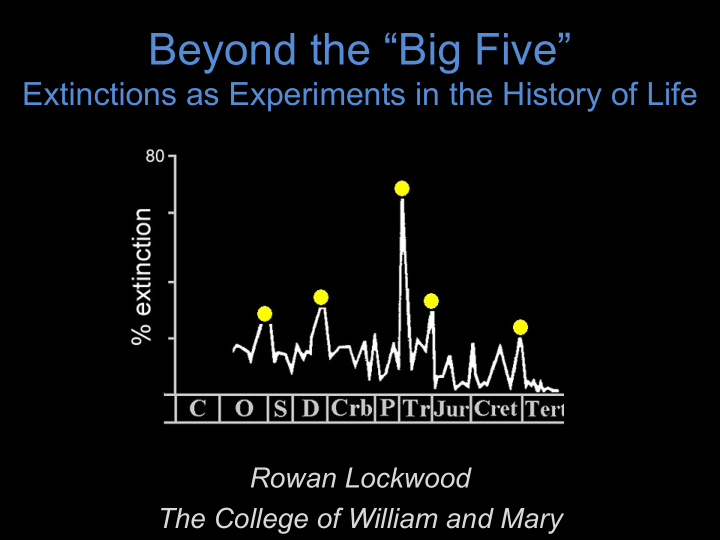



Beyond the “Big Five” Extinctions as Experiments in the History of Life Rowan Lockwood The College of William and Mary
Breakthroughs in Extinction Alvarez et al. (1980) hypothesis that an ET event was responsible for the K/T extinction Modified from Alvarez et al. 1980
Breakthroughs in Extinction Identification of the “Big 5” by Raup and Sepkoski (1982) Modified from Raup and Sepkoski 1982
“Extinction Industry” Handful of papers published in the 1950’s to 1% of all geology papers in 2002
Future Research Directions Fossil record is fertile ground for predicting effects of modern extinction Long time scales and large perturbations History of life has sample size of one Useful to view extinctions as repeated natural experiments in the history of life
Future Research Directions Will highlight a number of promising research directions • Exploring a central theme— evolutionary consequences of extinction • Focusing on three broad areas 1. Effects of selectivity 2. Importance of recovery intervals 3. Influence of spatial patterns
Effects of Selectivity Extinctions - Eliminate dominant and allow subordinate taxa to diversify - Redirect evo trends by eliminating innovations - Limit potential evolution by reducing variability Many of these mechanisms operate via selectivity
Selectivity: Trait Variation Majority of studies focus on mean or dominant traits Ignores trait variation-- prereq for evolution Modified from Kolbe et al. 2006
Selectivity: Multivariate Approaches Traditional approach- independent testing of traits Biological traits linked to one another-- which traits are actually selected for? Tools include regression, path analysis, structural equation modeling e.g., Harnik 2007, Payne & Finnegan 2007, Jablonski 2008 Modified from Erwin 1989
Selectivity: Background Extinction How does selectivity vary across extinctions of different magnitudes and durations? Modified from Lockwood 2005
Selectivity: Meta-analyses Several authors have provided reviews of the selectivity across events and taxonomic levels Missing a quantitative, meta-analytical approach to this often contradictory literature Recently applied successfully to live-dead studies and species-energy relationships Modified from Jablonski 2005
Importance of Recovery Intervals To understand influence of mass extinctions on evolutionary patterns, must examine both extinction and recovery Despite recent rise in recovery work, we still know little about recolonization Unfortunate given potential parallels between post-extinction recovery and restoration ecology
Recovery: Selectivity Evolutionary impact of recovery is closely tied to selectivity; few studies have examined this Failure to recover can be just as important as failure to survive Prolonged duration of recoveries increases importance to long-term macroevolutionary trends
Modified from Lockwood 2004
Recovery vs. Radiations Repeated nature of extinctions and recoveries allows us to test hypotheses of phylogenetic versus ecological constraint in the early evolution of clades e.g., Erwin et al. 1987, Foote 1996, 1999 Modified from Erwin et al. 1987
Recovery: Ecological & Evolutionary trends Few studies have assessed how trends, from latitudinal diversity gradients to onshore-offshore patterns of origination, shift across recovery intervals Modified from McGowan 2004
Influence of Spatial Patterns Studies of extinction often performed at outcrop or global scale Different responses in different regions can be used as controls in natural experiments of extinction Environmental factors important in one region may not be in another, allowing us to assess causal mechanisms
Spatial: Extinction vs. Emigration Difficult to differentiate extinction and origination from migration • Regional studies may help predict which ecosystems are likely to experience invasion Modified from Krug and Patzkowsky 2007
Spatial Autocorrelation Non-independence of samples in space serious problem for extinction studies Recognized as a potential bias in ecology Can highlight ecologically important mechanisms such as source-sink dynamics Handful of studies resample patterns environmentally, but not spatially
Preservation, Sampling, & Other Factors Understanding of intrinsic and extrinsic factors that affect extinction metrics Intrinsic factors include variable sampling, taxonomic standardization, etc. Extrinsic factors include availability of rock record, sequence architecture, etc. Recent attempts to control for both yield extremely volatile extinction rates (e.g., Foote 2007; Peters and Ausich 2008) Modified from Peters and Ausich 2008
Conclusions I Past century has witnessed significant breakthroughs in study of extinction in the fossil record Future research directions focus on three broad research areas 1. Effects of selectivity 2. Importance of recovery intervals 3. Influence of spatial patterns
Conclusions II Topics explored include: - Role that trait variation plays in survivorship - Comparative effects of extinctions of varying magnitudes on evolutionary patterns - Re-establishment of patterns in the aftermath of extinction - Extent to which spatial autocorrelation affects extinction patterns Useful to view extinctions as repeated natural experiments in the history of life and develop hypotheses to explicitly test across multiple events
Acknowledgments R. Bambach and P. Kelley for developing short course M. Foote, D. Jablonski, P. Wagner, J. Swaddle, M. Kosnik, P. Kelley, and A. Stigall for useful feedback ACS Petroleum Research Fund and the Jeffress Memorial Trust for funding Manuscript developed while a Sabbatical Fellow at the NCEAS, a Center funded by NSF (Grant #DEB-0553768), the University of California, Santa Barbara, and the State of California
Recommend
More recommend